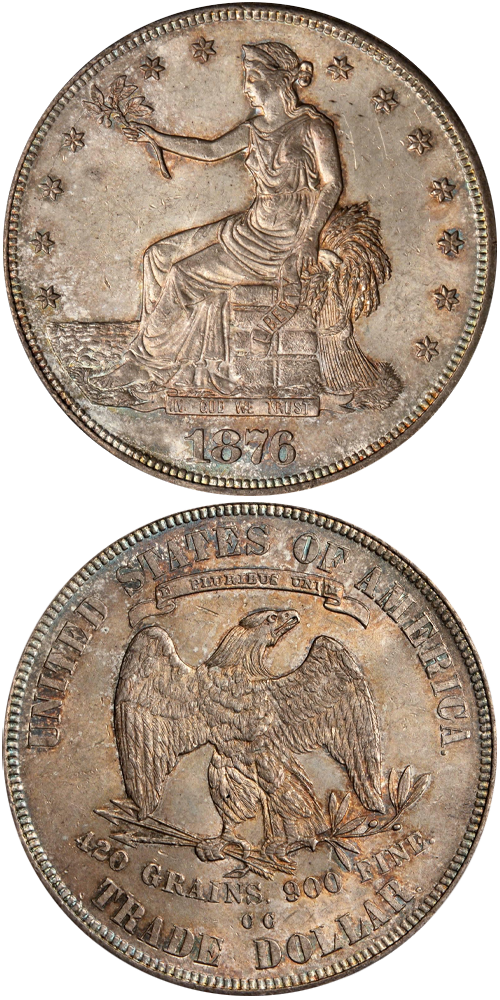1876-CC Trade Dollar
Jeff Ambio: This year represents the last in which the Type I obverse hub (ribbon ends pointing left) was employed in the production of trade dollars. The Type II reverse, introduced in 1875 and represented by the present 1876-CC, has no berry on the olive branch below the eagle's right (facing) talon.
Rusty Goe: Non-stop activity ensued at the Carson City Mint throughout January 1876 as workers stamped out 216,000 trade dollars that month. From all appearances, production of these exchange-coins would continue the pace established in 1875. But first, Superintendent Crawford would need to convince the U.S. government that his institution required more money to enable it to increase its business, or at the least sustain the levels reached the previous year. He traveled to Washington, DC, beginning around the middle of January on a nearly 30-day trip to plead his case.
About the same time, citizens of Carson City received word that Nevada's governor, lieutenant governor, and its legislators had memorialized the U.S. Senate, not for appropriations for the local mint, but rather to halt the efforts currently in motion to abolish it. Worse news arrived a month and a half later, when Congress slashed the mint's existing annual appropriations to less than one-fourth of its existing budget. Eventually, Mint Director Linderman, upon the urging of Representative Woodburn, "and some other Pacific Coast members," persuaded Congress to reconsider its ruling. Not only did it not quarter the existing appropriation, it increased it by $40,000 for wages and materials.
Trade dollar production in February and March 1876 averaged 82,500 pieces a month. Then in April, output surged to 128,000, which proved to be the final trade dollars minted in Carson City that year. For the next eight months, workers concentrated on delivering dimes, quarters, and half dollars.
Q. David Bowers: The mintage of Carson City trade dollars in 1876 receded to 509,000. Rusty Goe estimates that 805 to 1,300 exist in all grades but just 50 to 75 in Mint State.
In my Encyclopedia in 1993 I wrote this:
At the MS-65 level the 1876-CC may be unknown. In any Mint State grade it is a rarity. I estimate that just two to four MS-64 coins, only five to eight MS-63 pieces, and only 20 to 40 MS-60 to 62 specimens survive. These estimates are based upon conversations with specialists, printed population reports of certification services, and my own observations. As the rarity of the 1876-CC in Mint State is not widely known, certain professional numismatists and others have felt that it is not hard to find. For this reason, the population estimates I give in this book may err in being too liberal. Mint State coins may be even rarer than I say!
There are three sizes of mintmarks this year, small, medium, and large (tall).
The example to the left was sold by Stack's Bowers Galleries in the August 2012 Battle Born Collection of Carson City Coinage, where it realized $32,312.






